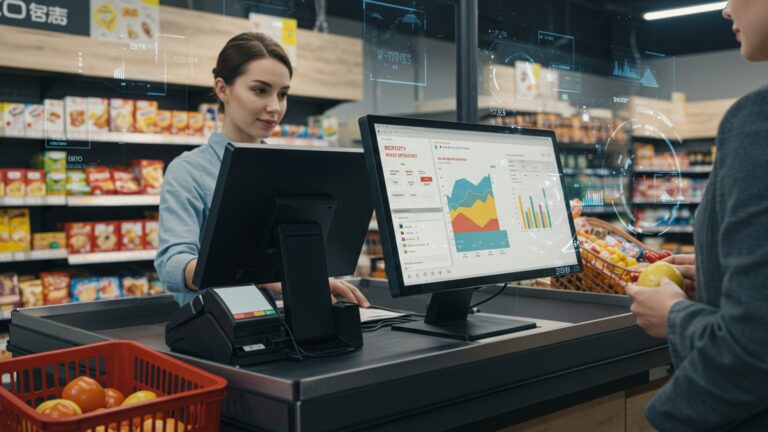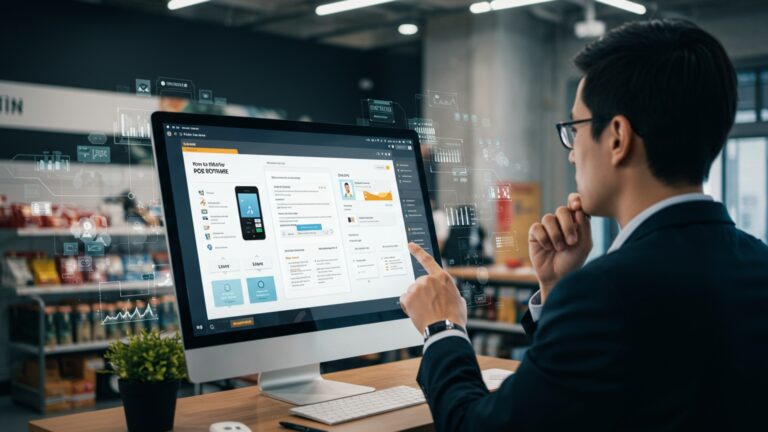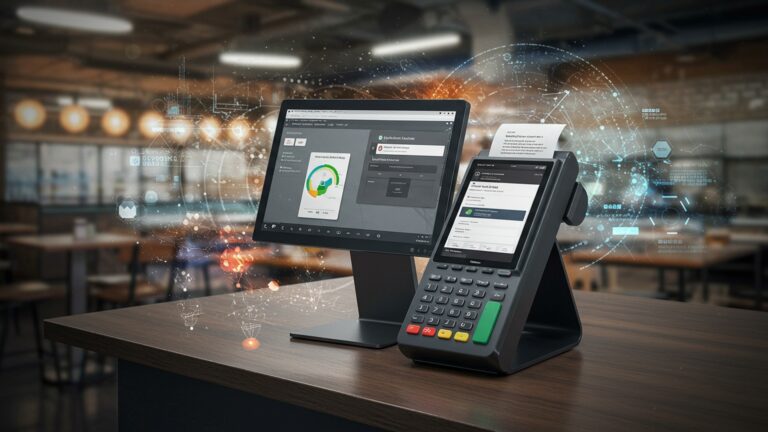How to Select the Best Billing and POS Software for Your Business
Navigating the complex landscape of operational technology, businesses face a critical juncture selecting robust billing and POS software. Beyond mere transaction processing, modern markets demand integrated solutions managing real-time inventory across multiple locations and powering personalized customer loyalty programs. Today’s platforms leverage cloud-based architecture and AI-driven analytics, offering mobile POS capabilities for pop-up shops or instant omnichannel sales data for large retail chains. The right system becomes a strategic asset, enhancing efficiency, reducing fraud. driving growth through actionable insights into sales patterns and customer behavior. Choosing wisely is paramount, as this technology forms the backbone of daily operations and future scalability.

Understanding Billing and POS Software
In today’s fast-paced business environment, efficient transaction processing and accurate record-keeping are paramount for success. Many businesses, from small boutiques to large restaurant chains, rely on specialized software to manage these critical operations. Often, the terms “billing software” and “POS software” are used interchangeably. while closely related and frequently integrated, they serve distinct primary functions.
What is POS (Point of Sale) Software?
POS software is the digital backbone of your sales transactions. It’s the system that allows your business to process customer purchases, whether in a physical store, online, or through a mobile device. Think of it as the modern cash register. infinitely more powerful. Its core functions typically include:
- Transaction Processing
- Inventory Management
- Customer Management
- Sales Reporting
Recording sales, accepting various payment methods (cash, card, mobile payments). issuing receipts.
Tracking stock levels in real-time, managing product variations. automating reorder points.
Storing customer data, managing loyalty programs. tracking purchase history.
Generating reports on sales trends, popular products, peak hours. employee performance.
For example, a retail store uses POS software to scan items, calculate totals, process payments. update inventory counts instantly. A restaurant utilizes it to take orders, send them to the kitchen, manage tables. process guest checks.
What is Billing Software?
Billing software, on the other hand, primarily focuses on generating invoices, managing accounts receivable. tracking payments for goods or services rendered. While POS systems often have basic billing capabilities for immediate transactions, dedicated billing software handles more complex invoicing scenarios, such as:
- Recurring Invoicing
- Project-Based Billing
- Payment Tracking
- Expense Management
Automating bills for subscription services or long-term contracts.
Creating invoices based on project milestones, hourly rates, or fixed fees.
Monitoring due dates, sending payment reminders. reconciling incoming payments.
Integrating with expenses to ensure accurate client billing.
A consulting firm, for instance, would use billing software to generate detailed invoices for clients based on hours worked or project phases, manage multiple payment terms. track outstanding balances.
The Synergy: Integrated Billing and POS Software
While distinct, the real power for many businesses lies in the integration of these two systems. A unified billing and pos software solution ensures that sales data from your POS flows seamlessly into your billing and accounting records. This integration eliminates manual data entry, reduces errors. provides a holistic view of your business’s financial health. For instance, when a product is sold via the POS, the inventory is updated, the sale is recorded. the revenue is automatically logged for billing and accounting purposes.
Key Features to Look for in Billing and POS Software
When evaluating potential billing and pos software solutions, a robust feature set is crucial. The right software should not only handle your current needs but also support your future growth. Here are the essential features to consider:
- Sales & Transaction Processing
- Multiple Payment Options
- Offline Mode
- Returns & Exchanges
- Customizable Receipts
- Inventory Management
- Real-time Tracking
- SKU Management
- Low Stock Alerts
- Vendor Management
- Barcode Scanning
- Customer Relationship Management (CRM)
- Customer Database
- Loyalty Programs
- Marketing Integrations
- Reporting & Analytics
- Sales Reports
- Employee Performance
- Inventory Reports
- Customizable Dashboards
- Employee Management
- User Permissions
- Time Clock
- Commission Tracking
- Integration Capabilities
- Accounting Software
- E-commerce Platforms
- Payment Gateways
- Third-Party Apps
- Security
- PCI Compliance
- Data Encryption
- User Authentication
- Scalability
- User Interface (UI) & Ease of Use
Support for credit/debit cards, mobile payments (Apple Pay, Google Pay), gift cards. split payments.
Ability to process transactions even without an internet connection, with data syncing once connectivity is restored.
Streamlined process for handling customer returns, refunds. exchanges.
Option to include branding, promotions. return policies on digital and printed receipts.
Accurate stock levels across all locations.
Efficient organization of products using Stock Keeping Units, including variations (size, color).
Automated notifications when inventory falls below a specified threshold.
Tracking supplier data, purchase orders. receiving inventory.
Quick and accurate item identification during sales and inventory counts.
Centralized storage of customer contact data and purchase history.
Tools to create and manage reward points, discounts. special offers.
Ability to connect with email marketing platforms for targeted campaigns.
Detailed insights into sales volume, revenue, average transaction value. top-selling products.
Tracking individual sales, hours worked. commission calculations.
Analysis of stock movement, dead stock. inventory turnover.
Visual representations of key metrics for quick decision-making.
Assigning specific roles and access levels to staff members.
Tracking employee work hours for payroll purposes.
Calculating sales commissions accurately.
Seamless integration with platforms like QuickBooks, Xero, or SAP.
Syncing online and in-store sales and inventory (e. g. , Shopify, WooCommerce).
Compatibility with preferred payment processors.
Connectors for marketing, HR, or specialized industry tools.
Adherence to Payment Card Industry Data Security Standard for secure transaction processing.
Protecting sensitive customer and business data.
Secure login procedures and multi-factor authentication.
The ability of the software to grow with your business, supporting additional locations, users. increasing transaction volumes without performance degradation.
An intuitive and easy-to-navigate interface reduces training time for staff and minimizes operational errors.
Deployment Options: Cloud vs. On-Premise
One of the foundational decisions when selecting billing and pos software is whether to opt for a cloud-based (SaaS) solution or an on-premise system. Each has distinct advantages and disadvantages that can impact your operations, costs. data control.
Cloud-Based (SaaS) Billing and POS Software
Cloud-based solutions, often referred to as Software-as-a-Service (SaaS), host the software and data on remote servers managed by the vendor. Users access the system via the internet, typically through a web browser or a dedicated app.
- Pros
- Accessibility
- Lower Upfront Costs
- Automatic Updates & Maintenance
- Scalability
- Data Backup
- Cons
- Internet Dependency
- Subscription Fees
- Data Security Concerns
- Limited Customization
- Use Cases
Access your system from anywhere, on any device with an internet connection. This is ideal for multi-location businesses or remote management.
Typically involves a monthly or annual subscription fee, eliminating large initial hardware and software purchase costs.
The vendor handles all software updates, security patches. system maintenance, reducing your IT burden.
Easily scale up or down based on business needs (e. g. , adding more users or locations) without significant infrastructure changes.
Vendors usually provide robust data backup and recovery solutions.
Requires a stable internet connection to function optimally (though many offer offline modes for basic transactions).
Ongoing costs can accumulate over time, potentially exceeding on-premise costs in the very long run.
You rely on the vendor’s security protocols for your sensitive data.
While many offer configuration options, deep customization might be restricted compared to on-premise solutions.
Small to medium-sized businesses, multi-location businesses, e-commerce heavy operations, businesses with remote employees, or those preferring operational expenditure (OpEx) over capital expenditure (CapEx).
On-Premise Billing and POS Software
On-premise solutions involve installing the software directly on your business’s own servers and computers. You are responsible for managing and maintaining the hardware, software. data.
- Pros
- Full Control & Data Ownership
- No Internet Dependency
- One-Time Cost
- Customization
- Enhanced Security (Potentially)
- Cons
- High Upfront Costs
- Maintenance & IT Burden
- Limited Remote Access
- Scalability Challenges
- Use Cases
You have complete control over your data and system infrastructure.
Operates independently of an internet connection (though cloud backups are still recommended).
After the initial purchase, there are no recurring software subscription fees (though maintenance and support contracts are common).
Often allows for deeper customization to fit highly specific business processes.
If you have a dedicated IT team, you can implement highly tailored security measures.
Significant initial investment in software licenses, servers. IT infrastructure.
You are responsible for all updates, security, backups. troubleshooting, requiring internal IT expertise or external support.
Access is typically restricted to your local network, making remote management challenging.
Scaling requires additional hardware and IT resources, which can be costly and time-consuming.
Larger enterprises with complex, highly customized needs, businesses in remote locations with unreliable internet, or organizations with stringent data sovereignty or compliance requirements that prefer in-house data control.
Comparison Table: Cloud vs. On-Premise Billing and POS Software
| Feature | Cloud-Based (SaaS) | On-Premise |
|---|---|---|
| Cost Structure | Subscription (monthly/annual) | High upfront (license, hardware), ongoing maintenance |
| Accessibility | Anywhere with internet | Typically local network only |
| Maintenance & Updates | Vendor managed (automatic) | Customer managed (manual) |
| Scalability | Easy, rapid scaling | Requires hardware upgrades, more complex |
| Data Control | Vendor manages, customer owns data | Customer has full control |
| Internet Dependency | High (though often offers offline mode) | Low (local operation) |
| Customization | Limited to configuration options | Potentially deep customization |
| Security | Vendor’s responsibility | Customer’s responsibility |
Industry-Specific Considerations
The “best” billing and pos software is rarely a one-size-fits-all solution. Different industries have unique operational workflows, regulatory requirements. customer engagement models that demand specialized features. Understanding these nuances is critical for making an informed choice.
Retail Businesses
Retail environments, from fashion boutiques to electronics stores, require robust inventory control and customer engagement features.
- Key Needs
- Advanced Inventory Management
- Omnichannel Capabilities
- Customer Loyalty Programs
- Returns & Exchanges
- Employee Management
- Real-world Example
Support for variants (size, color), multiple locations, stock transfers. automated reordering.
Seamless integration between physical stores, e-commerce websites. mobile apps to provide a consistent customer experience (e. g. , buy online, pick up in store).
Tools to create and manage rewards points, personalized discounts. customer segmentation for targeted marketing.
Efficient processing of returns, store credit. exchanges.
Tracking sales performance, commissions. shift management.
A clothing store might need to track inventory by size and color, offer loyalty points for repeat purchases. integrate with their Shopify store to synchronize online and in-store stock levels.
Restaurant and Hospitality Businesses
Restaurants, cafes, bars. hotels have highly specialized needs related to order management, table service. kitchen communication.
- Key Needs
- Table Management
- Kitchen Display Systems (KDS)
- Online Ordering & Delivery Integration
- Menu Management
- Ingredient Level Inventory
- Split Checks & Tipping
- Real-world Example
Visual floor plans, table status tracking. easy order routing.
Digital screens in the kitchen to display orders, manage prep times. ensure accuracy.
Seamlessly integrate with third-party delivery platforms or offer proprietary online ordering.
Easy updates for daily specials, ingredient tracking. allergen data.
Tracking raw ingredients to manage costs and reduce waste.
Flexible options for splitting bills and managing tips.
A busy restaurant benefits from a POS that allows servers to take orders tableside on a tablet, sends those orders directly to the KDS. easily splits checks for large groups, all while tracking ingredient usage for cost control.
Service Businesses
Businesses like salons, spas, repair shops. consulting firms focus more on appointment scheduling, service billing. recurring revenue.
- Key Needs
- Appointment Scheduling
- Service-Based Billing
- Recurring Billing
- Client Management
- Staff Scheduling
- Real-world Example
Integrated calendar management, online booking. automated reminders.
Ability to bill by hour, project, or fixed service package.
Automation for subscription services or retainer agreements.
Detailed client history, preferences. service records.
Managing employee availability and assignments.
A hair salon requires billing and pos software that handles online appointment booking, tracks client preferences (e. g. , hair color formulas), processes service payments. manages stylist commissions.
Healthcare and Professional Services
While often using more specialized Electronic Health Record (EHR) or Practice Management (PM) systems, these industries still require robust billing components with specific compliance needs.
- Key Needs
- HIPAA Compliance (for healthcare)
- Insurance Claim Processing
- Patient Billing
- Service Code Management
- Secure Data Handling
- Real-world Example
Ensuring data privacy and security.
Generating and submitting claims to various insurance providers.
Managing co-pays, deductibles. patient statements.
Using standardized codes (e. g. , CPT, ICD-10) for services.
Protecting sensitive client/patient insights.
A medical clinic would use a system that integrates appointment scheduling with patient billing, allows for the electronic submission of insurance claims. ensures all patient data is handled in compliance with HIPAA regulations.
The takeaway is clear: before diving into features, identify your industry’s specific demands. A general-purpose billing and pos software might offer basic functionality. an industry-specific solution will provide the specialized tools necessary for optimal efficiency and compliance.
Evaluating Vendors and Support
The software itself is only half the equation; the vendor behind it and the support they offer are equally critical. A powerful system is useless if you can’t get help when you need it or if the vendor’s business practices are unreliable. Due diligence in this area can save you significant headaches and costs down the line.
- Reputation and Reviews
- Industry-Specific Reviews
- Case Studies
- “Ask a Peer”
- Customer Support
- Availability
- Channels
- Response Time
- Quality of Support
- Training and Onboarding
- Onboarding Process
- Training Resources
- Ongoing Education
- Pricing Models
- Transparency
- Subscription vs. One-time
- Tiered Pricing
- Hardware Costs
- Payment Processing Fees
- Trial Periods and Demos
- Free Trials
- Personalized Demos
- Contract Terms and Scalability
- Contract Length
- Upgrade/Downgrade Options
- Exit Strategy
Look beyond generic reviews. Check platforms like G2, Capterra, Software Advice. even industry-specific forums for honest feedback.
Many vendors publish case studies. Look for businesses similar to yours to see how they’ve benefited.
Reach out to other business owners in your industry for their experiences and recommendations with specific billing and pos software.
Does the vendor offer 24/7 support? What are their hours of operation in your time zone?
How can you reach them? Phone, email, live chat, dedicated account manager?
What are their guaranteed response times for critical issues?
Are support staff knowledgeable and helpful? This is often revealed in reviews. Consider running a test call to their support line during your evaluation phase.
What kind of assistance do they provide during the initial setup and data migration?
Do they offer webinars, video tutorials, comprehensive knowledge bases, or in-person training?
How do they support your team as new features are released or as your staff changes?
Is the pricing clear and straightforward, or are there hidden fees?
comprehend if it’s a monthly/annual subscription, a perpetual license, or a hybrid model.
Many billing and pos software solutions offer different tiers based on features, users, or transaction volume. Ensure the tier you choose aligns with your current and future needs.
If physical POS terminals are required, are they included or purchased separately?
comprehend the associated transaction fees, as these can significantly impact your bottom line.
A trial period (e. g. , 7-30 days) is invaluable for hands-on testing with your actual business data.
Request a demo tailored to your specific business needs and industry. This is your chance to ask detailed questions and see features in action.
Are you locked into a long-term contract, or can you switch providers if the software doesn’t meet expectations?
Can you easily upgrade to a higher tier as your business grows or downgrade if necessary?
What happens to your data if you decide to leave the vendor? Can you export it easily?
The Selection Process: Actionable Steps
Choosing the right billing and pos software is a strategic decision that can significantly impact your business’s efficiency, profitability. customer satisfaction. By following a structured selection process, you can minimize risks and ensure you invest in a solution that truly meets your needs.
- Assess Your Business Needs and Goals
- Identify Pain Points
- List Essential Features
- Consider Future Growth
- Involve Key Stakeholders
- Set a Realistic Budget
- Upfront Costs
- Recurring Costs
- Hidden Costs
- ROI Consideration
- Research and Shortlist Options
- Online Search
- Read Reviews
- Ask for Recommendations
- Create a Shortlist
- Request Demos and Free Trials
- Personalized Demos
- Utilize Free Trials
- Test Scenarios
- Check for Integration Compatibility
- Existing Systems
- API Availability
- Read Reviews and Ask for References
- Deep Dive into Reviews
- Request References
- Consider Long-Term Scalability
- Growth Potential
- Feature Evolution
- Make an Informed Decision
- Compare Options
- Negotiate
- Review Contracts
What are the current challenges with your existing system (or lack thereof)? (e. g. , slow transactions, inaccurate inventory, difficult reporting).
Based on your industry and operations, what features are non-negotiable? (Refer back to the “Key Features” section).
Where do you see your business in 1, 3, or 5 years? Will the software accommodate new locations, increased sales volume, or additional services?
Get input from employees who will be using the software daily (sales staff, managers, accounting personnel). Their feedback is crucial for user adoption.
Include software licenses, hardware (POS terminals, barcode scanners, receipt printers). initial setup fees.
Account for monthly/annual subscription fees, payment processing fees. ongoing support contracts.
Factor in potential costs for training, data migration. any necessary integrations with existing systems.
Think about the potential return on investment (ROI) – how much will the software save you in time, errors. lost sales?
Use keywords like “retail POS software,” “restaurant billing system,” or “small business POS with inventory.”
Consult reputable review sites (Capterra, G2, Software Advice) and industry-specific publications.
Network with other business owners in your industry.
Narrow down your options to 3-5 top contenders that seem to align best with your needs and budget.
Schedule demos with each shortlisted vendor, ensuring they showcase features relevant to your business. Prepare a list of specific questions.
If available, take advantage of free trials. This is your chance to test the software hands-on with your own data (if possible) and evaluate its ease of use, interface. core functionalities. Involve your staff in this testing phase.
Run through common daily tasks, complex transactions, returns. reporting functions.
Verify if the billing and pos software integrates seamlessly with your current accounting software, e-commerce platform, CRM, or payroll system.
If direct integrations aren’t available, check if the software offers an API that allows for custom connections.
Pay attention to comments about customer support, reliability. specific features.
Ask vendors for references from businesses similar to yours. Speak directly with these references to get an unbiased perspective on their experience with the software and vendor.
Will the software support your business as it expands? Can it handle more users, locations, or product lines?
Does the vendor regularly update their software with new features and improvements? What is their development roadmap?
Create a comparison matrix of your top choices, weighing features, costs, support. scalability against your initial needs.
Don’t be afraid to negotiate pricing or ask for additional support during the initial setup phase.
Carefully read all terms and conditions before signing. Pay attention to contract length, cancellation policies. data ownership clauses.
Conclusion
Choosing the ideal billing and POS software isn’t merely about ticking features off a list; it’s a strategic investment that shapes your operational efficiency. My personal observation is that many businesses overlook their unique operational rhythm. For instance, a bustling multi-outlet garment shop needs different inventory sync capabilities than a single-location cafe, despite both needing a robust POS. Don’t just compare checklists; visualize your daily transactions and how the software fits. Embrace the current trend of cloud-native solutions. The ability to access real-time sales data from anywhere, even from your smartphone during a supplier meeting, is no longer a luxury but a competitive edge, offering insights unimaginable a decade ago. Therefore, I urge you to prioritize not just features. also scalability and, critically, responsive local support. Always request a genuine demo and speak to existing users; this hands-on validation is your most actionable step. Ultimately, the right system won’t just process payments; it will be the backbone that propels your business forward, freeing you to focus on growth and innovation. Make this choice thoughtfully. watch your operations transform.
More Articles
How to Select the Best POS Software in India for Your Business
How to Implement POS Software for Seamless Sales and Inventory Management
Master These 10 Invoice Best Practices to Ensure Faster Payments
How to Master Billing and POS Software for Efficient Retail Management
Learn 8 Smart Inventory Control Strategies Using POS in India
FAQs
I’m new to this. How do I even begin picking billing and POS software for my business?
Start by clearly defining your business’s specific needs. What problems are you trying to solve? List essential features like inventory management, sales tracking, payment processing. reporting. Think about your budget, the number of users. if you need it for a single location or multiple. This initial assessment will narrow down your options significantly.
What are the absolute must-have features I should look for?
Beyond basic sales and billing, prioritize features like robust inventory management (tracking stock levels, multiple locations), integrated payment processing (accepting various payment types), customer management (loyalty programs, purchase history), detailed reporting and analytics (sales trends, peak hours). employee management (permissions, time tracking). If you have an online store, e-commerce integration is crucial.
Cloud-based or installed software – what’s the difference and which is better?
Cloud-based (SaaS) means the software runs on the internet; you access it via a web browser. It’s generally more flexible, scalable. comes with automatic updates and backups. Installed (on-premise) software runs directly on your computers. It offers more control and potentially greater customization but requires your own IT management and upfront hardware costs. For most small to medium businesses, cloud-based is often the more convenient and cost-effective choice due to lower upfront costs and ease of maintenance.
How much should I budget for this kind of software?
Pricing varies wildly. Some offer free basic versions, while others charge hundreds or even thousands per month. Factors influencing cost include the number of features, users, locations. transaction volume. Most cloud solutions are subscription-based. Don’t just look at the monthly fee; consider setup costs, hardware requirements (like receipt printers or barcode scanners). potential training expenses. Always get a clear breakdown of all costs.
Will it play nice with my other business tools, like accounting software?
Integration is super vital! Look for software that can easily connect with your existing accounting platforms (like QuickBooks or Xero), e-commerce sites (Shopify, WooCommerce), or CRM systems. Good integration streamlines operations, reduces manual data entry. ensures consistent data across your business, saving you a lot of headaches and time.
I’m not a tech wizard. Is it going to be hard for me or my staff to learn?
User-friendliness is key. A complex system, no matter how powerful, will lead to frustration and errors. Look for an intuitive interface, clear navigation. easy-to-grasp workflows. Many providers offer free trials or demos, which are great opportunities to test it out with your team. Good customer support and training resources also make a big difference during the onboarding process.
What about customer support? What kind of help should I expect?
Reliable customer support is non-negotiable. Check what support channels are available (phone, email, live chat), their operating hours. response times. Read reviews about their support quality. Good support can be invaluable when you encounter issues, need help with a feature, or just have a quick question. Some providers offer tiered support plans, so interpret what’s included in your subscription.






